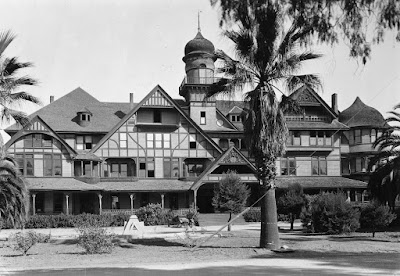 |
| Gramma's House |
Mom moved to La Verne to the Hillcrest Retirement Community in 1997 and then she moved into the Woods Health Services after her stroke in 2014. I visit her every six weeks or so. The little town hasn't changed much in all the years I've known it.
After the land was used by Native Americans and other early settlers, the land where La Verne now sits was owned by Isaac Wilson Lord. He was a Los Angeles business owner who, in 1887, convinced the Santa Fe Railroad to come out his way through his many acres of land. In May of that year, he made a bold move and set up parades and street music in both Los Angeles and San Bernardino, enticing people a free ride to Lordsburg. Over 2500 people accepted and Lord sold over $200,000 worth of lots.
 |
| Lordsburg Hotel/University of La Verne |
Then the railroad competition began with Santa Fe and Southern Pacific Railroads vying for customers. Passenger rates dropped to $1/person from mid-west to Los Angeles. It brought an influx of people to the area--most to just look around; some stayed.
With the hotel completed, waiting for paying customers, the little town of Lordsburg was ready to blossom. Only it never happened. Not one paying customer ever stayed at this glorious hotel. It seemed throughout the area there were few residents and many businesses.
 In 1889, M.M. Eshelman arrived from the midwest. He was a member of the Church of the Brethren. Along with George McDonaugh, also a Brethren, they made an offer to Lord for the hotel. The offer included 100 city lots in on the deal. They offered $15,000 for the lots and the hotel. They wanted to make a college out of the hotel. They enticed many Brethren to join them so their kids could go to college. It worked. By November, they had formed a Brethren congregation and by fall of 1891, the
college opened with eight faculty members and 135 students. Also in the northern lands there were a few ranchers. They called their area "La Verne," meaning "growing green."
In 1889, M.M. Eshelman arrived from the midwest. He was a member of the Church of the Brethren. Along with George McDonaugh, also a Brethren, they made an offer to Lord for the hotel. The offer included 100 city lots in on the deal. They offered $15,000 for the lots and the hotel. They wanted to make a college out of the hotel. They enticed many Brethren to join them so their kids could go to college. It worked. By November, they had formed a Brethren congregation and by fall of 1891, the
college opened with eight faculty members and 135 students. Also in the northern lands there were a few ranchers. They called their area "La Verne," meaning "growing green."  |
| Citrus groves with Mt Baldy in background |
 |
| Lighting smudge pots |
 |
| University of La Verne |
peace~~~

No comments:
Post a Comment